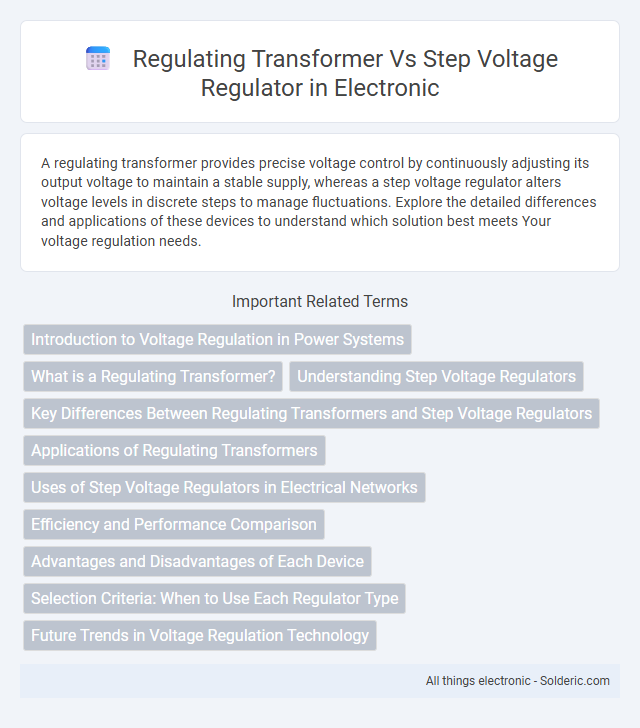A regulating transformer provides precise voltage control by continuously adjusting its output voltage to maintain a stable supply, whereas a step voltage regulator alters voltage levels in discrete steps to manage fluctuations. Explore the detailed differences and applications of these devices to understand which solution best meets Your voltage regulation needs.
Comparison Table
| Feature | Regulating Transformer | Step Voltage Regulator |
|---|---|---|
| Function | Maintains constant output voltage by adjusting transformer windings. | Controls output voltage by stepping voltage up or down in discrete increments. |
| Voltage Regulation | Continuous voltage regulation within a specified range. | Discrete voltage changes in fixed steps. |
| Operation | Uses variable transformer winding taps for smooth voltage control. | Employs taps and switches to select voltage steps. |
| Complexity | More complex construction and control mechanism. | Simpler design with mechanical or electronic switching. |
| Applications | Precision voltage control in industrial settings and laboratories. | Voltage stabilization for distribution transformers and power lines. |
| Response Time | Fast and continuous adjustment capability. | Slower due to stepwise voltage change. |
| Cost | Generally higher due to complexity. | Economical and widely used. |
Introduction to Voltage Regulation in Power Systems
Voltage regulation in power systems ensures stable voltage levels despite load variations, crucial for reliable device operation. Regulating transformers provide continuous voltage control with built-in tap changers for precise adjustments under load. Step voltage regulators achieve voltage regulation through discrete tap changes, offering effective load support and maintaining your system's voltage stability.
What is a Regulating Transformer?
A regulating transformer is a specialized device designed to maintain a constant output voltage despite variations in input voltage or load conditions, enhancing power quality and system stability. Unlike a step voltage regulator that adjusts voltage through taps or autotransformer action, the regulating transformer actively compensates for voltage fluctuations by controlling the magnetic flux within its core. Understanding the difference between these devices helps you select the appropriate solution for precise voltage control in electrical distribution systems.
Understanding Step Voltage Regulators
Step Voltage Regulators control voltage levels by automatically adjusting taps on a transformer to maintain a consistent output voltage despite input fluctuations. This precise regulation helps protect sensitive electrical equipment by minimizing voltage spikes and sags, ensuring your devices operate efficiently and reliably. Understanding the role of Step Voltage Regulators is essential for optimizing power quality in both residential and industrial applications.
Key Differences Between Regulating Transformers and Step Voltage Regulators
Regulating transformers provide continuous voltage adjustment through a variable magnetic flux, enabling precise voltage control with minimal voltage drops, while step voltage regulators use tap changers to adjust voltage in discrete steps. Regulating transformers are ideal for applications requiring fine voltage stabilization and low harmonic distortion, whereas step voltage regulators are more suited for infrastructures needing robust and cost-effective voltage correction over larger voltage ranges. The key difference lies in precision and operational mechanism: regulating transformers ensure smoother voltage output, whereas step voltage regulators offer simpler, stepped voltage changes.
Applications of Regulating Transformers
Regulating transformers are essential in optimizing voltage levels for sensitive equipment in industrial and commercial applications, ensuring stable power supply despite fluctuations. Unlike step voltage regulators, they provide continuous voltage regulation through adjustable tap changers, making them ideal for critical systems like data centers, telecommunication networks, and medical devices. Your facility benefits from enhanced reliability and reduced downtime by integrating regulating transformers into its power distribution setup.
Uses of Step Voltage Regulators in Electrical Networks
Step voltage regulators are widely used in electrical networks to maintain a consistent voltage level despite fluctuating load conditions, protecting sensitive equipment from voltage surges or drops. These devices are essential in distribution systems where voltage stability ensures efficient energy delivery and reduces power loss. Your electrical network benefits from step voltage regulators by improving system reliability and extending the lifespan of connected appliances.
Efficiency and Performance Comparison
Regulating transformers typically offer higher efficiency due to their ability to finely adjust voltage with minimal energy loss, making them ideal for sensitive electrical equipment requiring stable output. Step voltage regulators provide robust performance in maintaining voltage levels under varying load conditions but may exhibit slightly lower efficiency due to mechanical or tap-changing operations. Your choice should consider the specific application demands, balancing the precision of regulating transformers against the durability and cost-effectiveness of step voltage regulators.
Advantages and Disadvantages of Each Device
Transformers provide stable voltage regulation with high efficiency and low maintenance, making them ideal for consistent voltage requirements, but they lack the ability to adjust voltage dynamically under varying load conditions. Step voltage regulators offer precise voltage control and automatic adjustment to load fluctuations, enhancing power quality and protection; however, they tend to be more complex, costly, and require regular maintenance. Each device's suitability depends on the application's demand for voltage stability versus flexibility and maintenance resources.
Selection Criteria: When to Use Each Regulator Type
Selecting between a regulating transformer and a step voltage regulator depends on your specific voltage stabilization needs and load characteristics. Use a regulating transformer when precise, continuous voltage adjustment is required for sensitive equipment, ensuring minimal voltage fluctuations and harmonic distortion. Choose a step voltage regulator for applications needing discrete voltage level changes and simpler control, especially in distribution systems with moderate load variability.
Future Trends in Voltage Regulation Technology
Future trends in voltage regulation technology emphasize intelligent transformers integrated with IoT sensors and real-time analytics to enhance grid stability and energy efficiency, outperforming traditional step voltage regulators. Advanced regulating transformers leverage solid-state components, enabling rapid voltage adjustments with minimal losses and improved response to dynamic load changes. The shift towards smart grids accelerates the adoption of adaptive voltage regulation methods, incorporating machine learning algorithms that optimize transformer tap settings for predictive maintenance and load balancing.
regulating transformer vs step voltage regulator Infographic

 solderic.com
solderic.com